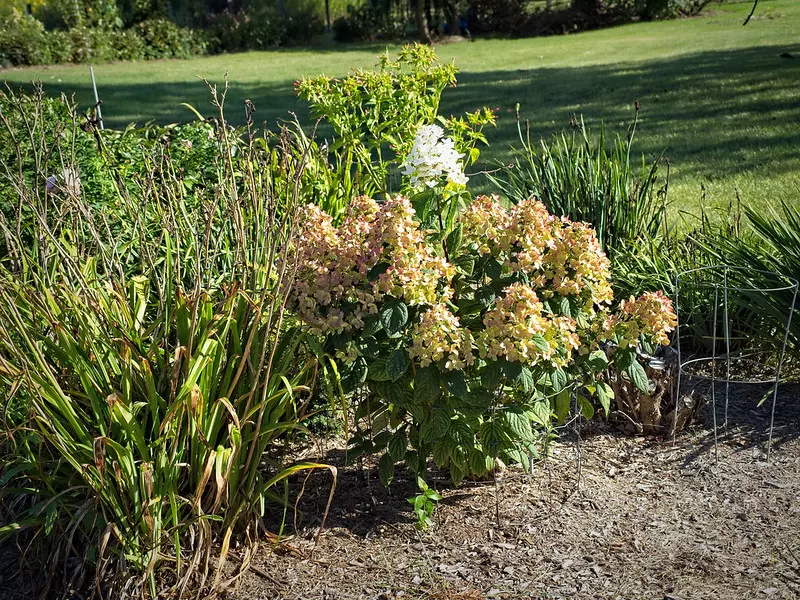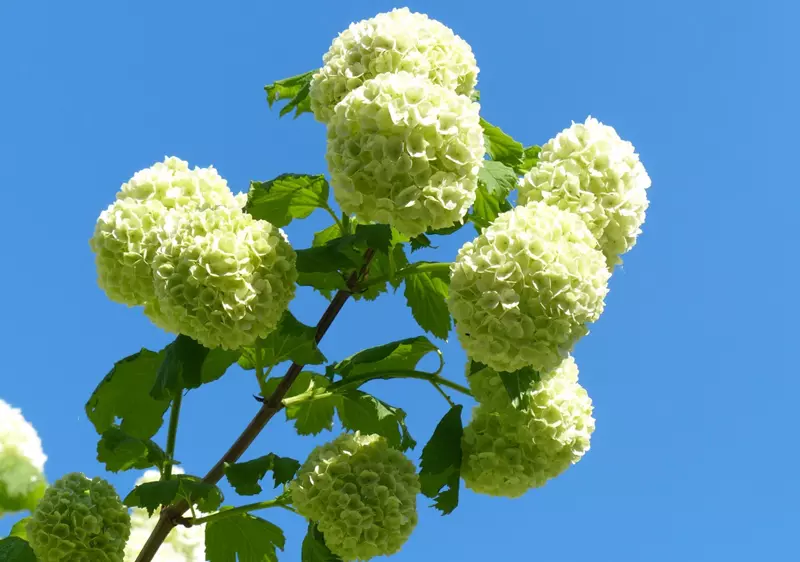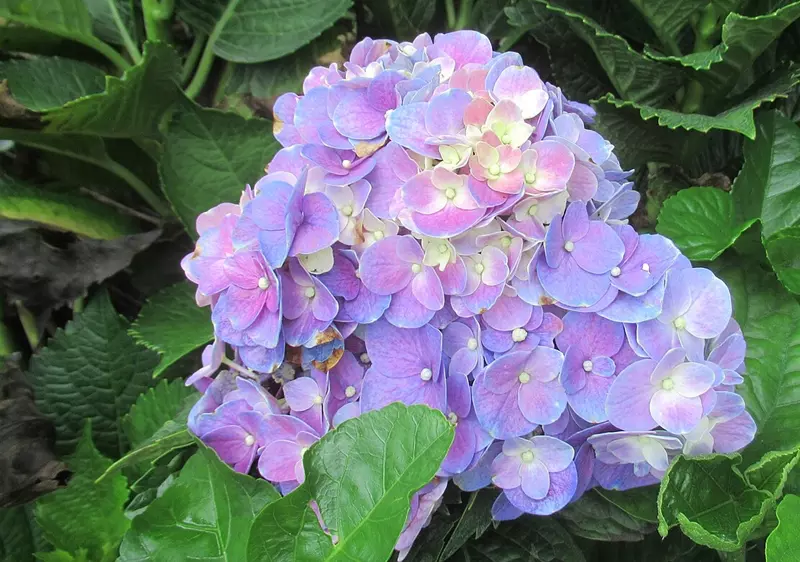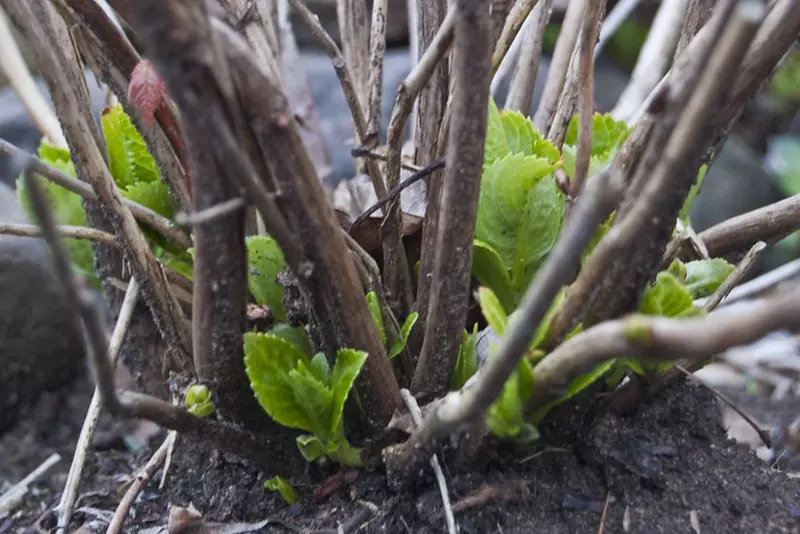Table of Contents
Hydrangeas are adored for their lush blooms and versatility in the garden. However, growing these plants in hot climates can be challenging without proper care. This guide offers tips to help you nurture your hydrangeas, ensuring they thrive even in extreme heat.
 Source: flickr.com; Author: F. D. Richards; License: CC BY-SA 2.0
Source: flickr.com; Author: F. D. Richards; License: CC BY-SA 2.0
Choosing Heat-Tolerant Hydrangea Varieties
Heat tolerance in hydrangeas refers to a plant's ability to endure and thrive in elevated temperatures without succumbing to stress or damage. Factors influencing heat tolerance include:
- Species Characteristics: Some hydrangea species are inherently more adaptable to heat due to their native habitats.
- Soil Moisture: Adequate moisture levels help hydrangeas cope with heat by maintaining cellular functions.
- Shade Availability: Partial shade can protect hydrangeas from intense midday sun, reducing heat stress.
Top Heat-Tolerant Hydrangea Varieties
Several hydrangea varieties are well-suited for hot climates. Here are some notable options:
-
Panicle Hydrangea (Hydrangea paniculata)
Known for its large, cone-shaped flower clusters, Panicle Hydrangea is exceptionally hardy and heat tolerant. It can thrive in full sun and is less fussy about soil conditions. This variety blooms on new wood, ensuring reliable flowering even after harsh winters or pruning.
-
Oakleaf Hydrangea (Hydrangea quercifolia)
Recognisable by its lobed leaves resembling oak leaves, this variety is native to the southeastern United States and is well-adapted to warmer climates. It displays impressive heat tolerance and offers year-round interest with its foliage and blooms.
-
Smooth Hydrangea (Hydrangea arborescens)
This variety is accustomed to warmer climates and can handle heat when provided with adequate moisture. Its large, round flower clusters are a highlight in summer gardens.
-
Bigleaf Hydrangea (Hydrangea macrophylla)
While traditionally suited for cooler climates, certain cultivars have been developed to withstand higher temperatures. These varieties often require some afternoon shade in hotter regions to prevent wilting.
Factors to Consider When Selecting Heat-Tolerant Hydrangeas
When choosing hydrangea varieties for hot climates, consider the following factors:
- Hardiness Zone: Ensure the variety is suitable for your specific USDA hardiness zone to guarantee optimal growth.
- Sun Exposure: Determine the amount of sunlight your garden receives and select varieties that can tolerate those conditions.
- Soil Type: Hydrangeas prefer well-drained, fertile soil. Amending the soil with organic matter can improve moisture retention, beneficial in hot climates.
- Watering Needs: Consistent watering is crucial, especially during prolonged heat spells. Consider installing a drip irrigation system to maintain adequate soil moisture.
Additional Tips for Growing Hydrangeas in Hot Climates
To ensure the success of your heat-tolerant hydrangeas, keep the following tips in mind:
- Mulching: Apply a 2–3 inch layer of organic mulch around the base of the plant to help retain soil moisture and regulate temperature.
- Pruning: Prune hydrangeas at the appropriate time for the specific variety to encourage healthy growth and abundant blooms.
- Fertilisation: Use a balanced, slow-release fertiliser in early spring to provide essential nutrients throughout the growing season.
- Pest and Disease Management: Regularly inspect plants for signs of pests or diseases and take prompt action to address any issues.
By carefully selecting heat-tolerant hydrangea varieties and providing appropriate care, you can enjoy the beauty of these plants even in hot climates. Consider the specific needs of each variety and tailor your gardening practices to create an environment where your hydrangeas can thrive.
Selecting the Ideal Planting Location
Hydrangeas' light needs vary by species, and in hot climates, providing appropriate light exposure is essential:
- Partial Shade: Most hydrangeas thrive in locations with morning sun and afternoon shade, protecting them from intense midday heat.
- Full Sun Tolerance: Certain species, like Panicle Hydrangeas (Hydrangea paniculata), can tolerate full sun if adequate moisture is maintained.
Optimal Soil Conditions
Soil quality significantly impacts hydrangea health:
- Well-Drained Soil: Ensure the planting site has soil that drains well to prevent root rot, especially important in humid, hot climates.
- Moisture Retention: Incorporate organic matter, such as compost, to enhance moisture retention without waterlogging the roots.
Importance of Air Circulation
Good air circulation helps reduce the risk of fungal diseases:
- Spacing: Plant hydrangeas with sufficient space between them to allow air to flow freely, aiding in moisture evaporation from foliage.
- Avoid Crowded Areas: Refrain from planting hydrangeas too close to other large shrubs or structures that could impede airflow.
Protection from Harsh Elements
Shielding hydrangeas from extreme weather conditions is vital:
- Wind Barriers: Utilise natural windbreaks, such as hedges or fences, to protect plants from drying winds common in hot climates.
- Mulching: Apply a 2–3 inch layer of organic mulch around the base to regulate soil temperature and conserve moisture.
Considering Microclimates
Microclimates within your garden can influence hydrangea success:
- Cooler Spots: Identify areas that remain cooler during peak heat, such as locations shaded by taller trees during the hottest part of the day.
- Humidity Levels: Areas with higher humidity can benefit hydrangeas, as they prefer moist environments.
Planting Timing and Techniques
When and how you plant hydrangeas affect their establishment:
- Autumn Planting: In warmer climates, planting in autumn allows roots to establish before the onset of summer heat.
- Proper Depth: Plant hydrangeas at the same depth they were in their nursery pots to prevent stress and encourage healthy growth.
By carefully selecting the planting location and considering factors such as light exposure, soil conditions, and protection from harsh elements, you can create an environment where hydrangeas will flourish even in hot climates.
Soil Preparation and Mulching
Hydrangeas flourish in well-drained, fertile soils with adequate moisture retention. Key considerations include:
- Soil Texture: Aim for loamy soil that balances sand, silt, and clay to provide both drainage and moisture retention.
- Soil pH: Hydrangea flower colour is influenced by soil pH. Acidic soils (pH below 6) produce blue flowers, while alkaline soils (pH above 7) yield pink blooms. Adjust pH accordingly to achieve desired flower colours.
Steps for Effective Soil Preparation
Proper soil preparation enhances hydrangea growth, especially in hot climates:
- Soil Testing: Conduct a soil test to determine pH and nutrient levels, guiding necessary amendments.
- Amending Soil: Incorporate organic matter such as compost or well-rotted manure to improve fertility and moisture retention. This is particularly beneficial in sandy soils, which drain quickly.
- Ensuring Drainage: For clay soils, add coarse sand or perlite to enhance drainage and prevent waterlogging, which can be detrimental in hot climates.
The Importance of Mulching
Mulching offers several benefits crucial for hydrangeas in hot climates:
- Moisture Retention: Mulch reduces soil evaporation, maintaining consistent moisture levels essential for hydrangea health.
- Temperature Regulation: A mulch layer insulates the soil, protecting roots from extreme temperatures.
- Weed Suppression: Mulch inhibits weed growth, reducing competition for nutrients and water.
- Soil Improvement: Organic mulches decompose over time, enriching the soil with beneficial nutrients.
Choosing the Right Mulch
Selecting appropriate mulch enhances its effectiveness:
- Organic Mulches: Materials like pine bark, wood chips, or compost are ideal. Pine bark, for instance, is beneficial for hydrangeas due to its moisture retention properties.
- Mulch Depth: Apply a 2–3 inch layer to provide adequate coverage without suffocating the roots.
- Application Technique: Keep mulch a few inches away from the base of the plant to prevent stem rot and allow air circulation.
Best Practices for Mulching in Hot Climates
Implement these strategies to maximise mulching benefits:
- Timing: Apply mulch in late spring to early summer to prepare for peak temperatures. Refreshing the mulch layer in mid-summer can further protect roots during the hottest months.
- Watering Considerations: Water the soil thoroughly before mulching to lock in moisture. Continue regular watering, as mulch aids retention but doesn't replace the need for irrigation.
- Monitoring: Regularly check soil moisture levels to ensure they remain consistent, adjusting watering practices as necessary.
By focusing on meticulous soil preparation and strategic mulching, you can create an environment where hydrangeas flourish, even in challenging hot climates. These practices support robust growth, vibrant blooms, and overall plant vitality.
The Secret to Successful Hydrangea Planting in Hot Climates<
Planting hydrangeas in hot climates requires careful preparation to ensure their survival and growth. One crucial step is thoroughly hydrating the plant before placing it in the ground. This article delves into the importance of pre-soaking hydrangeas and provides detailed planting instructions to enhance their establishment in warm environments.
The Importance of Pre-Soaking Hydrangeas
Hydrangeas thrive in consistently moist soil, but overwatering can lead to root rot and wilting, while underwatering can cause stunted growth and lacklustre blooms. In hot climates, soil moisture can evaporate quickly, increasing the risk of transplant shock for newly planted hydrangeas. Pre-soaking the plant ensures that the root ball is adequately hydrated, providing a reservoir of moisture that supports the plant during the critical initial phase after planting.
Step-by-Step Guide to Pre-Soaking and Planting
1. Prepare the Soaking Container
Select a bucket or container large enough to fully submerge the hydrangea's pot. Fill it with clean water, ensuring the temperature is moderate to avoid shocking the plant.
2. Submerge the Potted Hydrangea
Gently place the entire potted hydrangea into the water, ensuring it is fully submerged. Hold it under the surface until air bubbles cease to rise, indicating that the root ball is saturated. This process typically takes 1-2 minutes.
3. Prepare the Planting Hole
While the hydrangea is soaking, dig a planting hole twice as wide and slightly shallower than the root ball. This allows the roots to spread easily and ensures the top of the root ball sits slightly above ground level, promoting proper drainage.
4. Remove the Hydrangea from Its Pot
After soaking, carefully remove the hydrangea from its pot. If the roots are tightly bound, gently loosen them to encourage outward growth.
5. Position the Plant
Place the hydrangea in the prepared hole, ensuring it is upright and the top of the root ball is level with or slightly above the surrounding soil.
6. Backfill and Firm the Soil
Backfill the hole with the excavated soil, pressing it firmly around the root ball to eliminate air pockets. Treading the soil gently with your foot can help secure the plant and ensure good root-to-soil contact.
7. Water Thoroughly
After planting, water the hydrangea generously to settle the soil and provide additional moisture. This initial watering is crucial for hydrangeas to establish well and begin their growth journey in the ground.
Additional Tips for Planting Hydrangeas in Hot Climates
- Mulching: Apply a 2-3 inch layer of organic mulch around the base of the plant to retain soil moisture and regulate temperature.
- Watering Schedule: Monitor soil moisture regularly and water deeply when the top inch of soil feels dry. During hot, dry spells, you may need to water your plants every day or even twice a day to avoid subjecting them to heat stress.
- Shade Provision: In extremely hot climates, consider providing partial shade during the hottest part of the day to protect the hydrangea from excessive sun exposure.
Proper planting techniques are vital for the success of hydrangeas in hot climates. By pre-soaking the plant, ensuring firm soil contact, and following appropriate aftercare, you can enhance the establishment and longevity of your hydrangeas, allowing them to thrive even in challenging conditions.
Watering Strategies
Hydrangeas thrive in consistently moist, well-drained soil. In hot climates, increased temperatures and evaporation rates necessitate careful attention to their watering needs. Key considerations include:
- Species Variations: Different hydrangea species have varying water requirements. For instance, Bigleaf Hydrangeas (Hydrangea macrophylla) often need more water compared to Panicle Hydrangeas (Hydrangea paniculata).
- Soil Type: Well-draining soil that retains moisture is ideal. Sandy soils may require more frequent watering, while clay soils retain moisture longer.
- Sun Exposure: Hydrangeas in full sun may need more frequent watering than those in partial shade.
Optimal Watering Techniques
Implementing proper watering techniques ensures deep root hydration and reduces plant stress:
- Deep Watering: Water deeply to encourage roots to grow deeper into the soil, enhancing drought resistance. This involves soaking the soil to a depth of at least 6 inches.
- Watering Schedule: In hot weather, water hydrangeas 3–4 times a week, adjusting based on rainfall and soil moisture levels. It's better to water deeply a few times a week than to water lightly every day.
- Time of Day: Water in the early morning to reduce evaporation and allow plants to absorb moisture before the day's heat intensifies.
- Avoid Overhead Watering: Direct water at the base of the plant to keep foliage dry, reducing the risk of fungal diseases.
Mulching to Retain Soil Moisture
Applying mulch around hydrangeas helps conserve soil moisture and regulate temperature:
- Mulch Type: Use organic mulches like pine bark, wood chips, or compost to improve moisture retention.
- Application Depth: Apply a 2–3 inch layer of mulch around the base of the plant, keeping it a few inches away from the stems to prevent rot.
- Mulch Timing: Apply mulch in late spring to early summer to prepare for peak temperatures. Refreshing the mulch layer in mid-summer can further protect roots during the hottest months.
Monitoring Plant Health
Regular observation helps identify signs of water stress:
- Wilting Leaves: Drooping leaves may indicate dehydration; increase watering frequency if observed.
- Yellowing Leaves: This can be a sign of overwatering; ensure soil is well-drained and adjust watering accordingly.
- Soil Moisture Check: Regularly check soil moisture by inserting a finger into the soil up to 2 inches deep; if it feels dry, it's time to water.
Additional Tips for Hot Climates
Consider these strategies to support hydrangeas during extreme heat:
- Provide Shade: Use shade cloths or plant hydrangeas in locations with afternoon shade to protect them from intense sun.
- Soil Amendments: Incorporate organic matter to improve soil structure and moisture retention.
- Consistent Watering: Maintain a regular watering schedule, especially during heatwaves, to prevent stress.
By implementing these watering strategies, you can help your hydrangeas thrive even in hot climates, ensuring they remain a vibrant addition to your garden.
Pruning Practices
Hydrangeas can be classified based on their blooming patterns:
- Old Wood Bloomers: Varieties like Bigleaf (Hydrangea macrophylla) and Oakleaf (Hydrangea quercifolia) produce flowers on stems from the previous year. Pruning in autumn can remove these buds, leading to reduced flowering.
- New Wood Bloomers: Species such as Panicle (Hydrangea paniculata) and Smooth Hydrangea (Hydrangea arborescens) bloom on current year's growth. While they can tolerate late winter pruning, it's still advisable to wait until early spring in hot climates to assess any winter damage.
Why Spring Pruning is Beneficial
Pruning hydrangeas in early spring offers several advantages:
- Assessment of Winter Damage: By waiting until after the last frost, you can identify and remove any stems damaged by cold weather, ensuring only healthy wood remains.
- Preservation of Flower Buds: For old wood bloomers, delaying pruning until spring prevents the accidental removal of flower buds set during the previous season.
- Enhanced Plant Structure: Spring pruning allows for the removal of weak or crossing branches, promoting better air circulation and reducing the risk of disease, which is particularly important in hot, humid climates.
Steps for Effective Spring Pruning
Follow these steps to prune your hydrangeas successfully:
- Wait for the Right Time: Ensure all risk of frost has passed, typically around March, before commencing pruning.
- Inspect the Plant: Examine your hydrangea for any dead, damaged, or diseased wood.
- Remove Dead or Damaged Stems: Using clean, sharp pruning shears, cut back any dead or frost-damaged stems to healthy tissue.
- Thin Out Older Stems: For mature plants, remove a few of the oldest stems at the base to encourage vigorous new growth.
- Shape the Plant: Trim back any wayward branches to maintain the desired shape, being careful not to remove too much live wood.
- Avoid Cutting New Buds: Take care not to prune off the swelling buds on old wood bloomers, as these will produce the season's flowers.
Additional Tips for Hot Climates
Consider these practices to support your hydrangeas:
- Mulching: Apply a 2–3 inch layer of organic mulch around the base of the plant to conserve moisture and regulate soil temperature.
- Watering: Provide consistent moisture, especially during dry spells, to prevent stress and promote healthy growth.
- Protection from Afternoon Sun: In extremely hot climates, consider planting hydrangeas where they receive morning sun and afternoon shade to reduce heat stress.
By adhering to these spring pruning practices, you can enhance the health and beauty of your hydrangeas, ensuring they remain a stunning feature in your garden throughout the growing season.
Pest and Disease Management in Hot Climate
Several pests thrive in warm conditions and can adversely affect hydrangeas:
- Aphids: Small, sap-sucking insects that cluster on new growth, causing distorted leaves and excreting honeydew, which can lead to sooty mould. Regular inspection and the use of insecticidal soap can help control aphid populations.
- Spider Mites: Tiny arachnids that flourish in hot, dry conditions, leading to stippled, yellowing leaves and fine webbing. Mitigation includes maintaining adequate humidity and applying miticides if infestations become severe.
- Scale Insects: Hard-shelled pests that attach to stems and leaves, extracting sap and weakening the plant. Treatment involves pruning affected areas and applying horticultural oil to suffocate the insects.
Diseases Prevalent in Warm Conditions
Hydrangeas in hot climates are prone to several diseases, often exacerbated by high humidity and temperature:
- Powdery Mildew: Characterised by a white or grey powdery coating on leaves and stems, this fungal disease thrives in warm, humid environments. To manage, ensure proper air circulation, avoid overhead watering, and apply fungicides as necessary.
- Leaf Spot Diseases: Fungal pathogens cause brown or black spots on leaves, leading to premature leaf drop. Preventative measures include watering at the base to keep foliage dry, spacing plants to enhance air flow, and removing and disposing of infected leaves promptly.
- Root Rot: Excessive soil moisture and poor drainage can lead to root rot, causing wilting and yellowing leaves. To prevent this, plant hydrangeas in well-draining soil and avoid overwatering.
Environmental Stressors
In hot climates, hydrangeas may experience stress due to environmental factors:
- Sunburned Leaves: Excessive direct sunlight can cause leaf scorch, resulting in brown or bleached patches. To mitigate, plant hydrangeas in locations with morning sun and afternoon shade, or provide artificial shading during peak sunlight hours.
- Water Stress: Both drought and overwatering can harm hydrangeas. Maintain consistent soil moisture, ensuring the soil is moist but not waterlogged, and adjust watering practices during extreme heat.
Preventative Measures and Best Practices
Implementing the following strategies can help maintain healthy hydrangeas in hot climates:
- Proper Planting Location: Choose sites with partial shade, especially during the hottest part of the day, to reduce heat stress.
- Soil Preparation: Ensure well-draining soil enriched with organic matter to promote healthy root development and prevent waterlogging.
- Regular Monitoring: Frequently inspect plants for signs of pests, diseases, or stress, allowing for early intervention and treatment.
- Pruning and Sanitation: Remove dead or diseased plant material promptly to prevent the spread of pathogens, and sterilise pruning tools between uses.
- Mulching: Apply a 2–3 inch layer of organic mulch around the base of the plant to conserve soil moisture and regulate temperature, keeping mulch a few inches away from the stems to prevent rot.
By understanding the specific challenges posed by hot climates and implementing these management practices, you can ensure your hydrangeas remain healthy and continue to enhance your garden with their beauty.
Common Fungal Infections in Hot Climates
- Powdery Mildew: Characterised by a white or grey powdery coating on leaves and stems, this fungus thrives in warm, humid conditions.
- Leaf Spot Diseases: Caused by various fungal pathogens, these present as brown or black spots on foliage, often leading to premature leaf drop.
- Anthracnose: A severe fungal disease that results in large, irregular brown spots on leaves and can affect blooms and stems.
Preventative Measures
1. Optimal Planting Location
Select a site with morning sun and afternoon shade to reduce heat stress and minimise fungal proliferation.
2. Adequate Spacing
Ensure sufficient spacing between plants to promote air circulation, reducing humidity levels around foliage and deterring fungal growth.
3. Watering Practices
- Soil Moisture: Maintain consistent soil moisture without overwatering. Overly wet soil can encourage fungal infections.
- Watering Technique: Apply water directly to the soil at the base of the plant, avoiding overhead watering to keep foliage dry.
4. Mulching
Apply a 2–3 inch layer of organic mulch around the base of the plant to conserve moisture and regulate soil temperature, keeping mulch a few inches away from the stems to prevent rot.
5. Pruning
Regularly remove dead or diseased plant material to improve air circulation and reduce the likelihood of fungal infections.
Identification and Treatment
1. Regular Monitoring
Inspect plants weekly for early signs of fungal infections, such as discoloured spots, powdery residues, or wilting leaves.
2. Organic Remedies
- Neem Oil: A natural fungicide effective against various fungal diseases. Apply as per manufacturer instructions.
- Baking Soda Solution: Mix 1 tablespoon of baking soda with 1 gallon of water and a few drops of liquid soap. Spray on affected areas to combat fungal growth.
3. Chemical Fungicides
In cases of severe infection, consider using commercial fungicides labelled safe for hydrangeas, following the manufacturer's guidelines for application.
By implementing these preventative measures and treatments, you can safeguard your hydrangeas against heat-related fungal infections, ensuring they remain healthy and continue to enhance your garden with their beauty.
Common Insect Pests
- Aphids: Small, soft-bodied insects that feed on plant sap, causing distorted growth and excreting honeydew, which leads to sooty mould.
- Spider Mites: Tiny arachnids that thrive in hot, dry conditions, feeding on the undersides of leaves and causing stippling, yellowing, and eventual leaf drop.
- Japanese Beetles: Metallic green beetles that feed on hydrangea foliage, skeletonising leaves and reducing the plant's vigour.
- Slugs and Snails: Molluscs that chew irregular holes in leaves, particularly affecting young hydrangeas.
Preventative Measures
1. Cultural Practices
Maintain plant health through proper watering, fertilisation, and pruning to enhance resilience against pests.
2. Physical Barriers
Use row covers or fine mesh netting to protect hydrangeas from insect invasion, especially during peak pest activity periods.
3. Companion Planting
Planting herbs like basil or flowers like marigolds near hydrangeas can repel certain pests due to their strong scents.
4. Regular Monitoring
Inspect plants weekly for early signs of pest activity, such as discoloured leaves, holes, or the presence of insects, to enable prompt intervention.
Treatment Options
1. Organic Methods
- Insecticidal Soap: Effective against soft-bodied insects like aphids; apply according to manufacturer instructions.
- Neem Oil: A natural pesticide that disrupts insect hormone systems; suitable for controlling a range of pests.
- Handpicking: Physically remove larger pests like Japanese beetles and slugs during early morning or late evening when they are less active.
2. Chemical Controls
In cases of severe infestation, consider using chemical insecticides labelled safe for hydrangeas, following the manufacturer's guidelines for application.
3. Biological Controls
Introduce natural predators, such as ladybirds for aphid control or predatory mites for spider mite management, to reduce pest populations.
By understanding the common insect pests that affect hydrangeas in warm climates and implementing these preventative and treatment strategies, you can maintain the health and beauty of your plants, ensuring they continue to thrive and enhance your garden.
Common Leaf Damage on Hydrangeas: Causes and Solutions
Types of Leaf Damage
- Yellowing Leaves: Leaves lose their green colour, turning pale or yellow.
- Brown Spots: Dark, necrotic areas appearing on leaf surfaces.
- Wilting: Leaves droop and lose turgidity.
- Leaf Scorch: Browning or burning of leaf edges and tips.
- Holes in Leaves: Physical damage resulting in perforations.
Causes of Leaf Damage
1. Environmental Stress
High temperatures exceeding 90°F (32°C) can cause wilting and damage to hydrangea leaves, flowers, and overall health. Sudden temperature changes may also lead to yellowing and wilting of foliage.
2. Water Stress
Both overwatering and underwatering can lead to leaf issues. Overwatering may cause yellowing leaves due to root rot, while underwatering can result in wilting and leaf scorch.
3. Nutrient Deficiencies
Lack of essential nutrients, particularly iron or nitrogen, can cause yellowing leaves. Improper soil pH can also hinder nutrient uptake, leading to chlorosis.
4. Pests and Diseases
Insect pests like aphids and spider mites, as well as fungal infections such as powdery mildew, can cause various leaf damages, including spots, wilting, and holes.
Preventive Measures
1. Proper Watering
Maintain consistent soil moisture without overwatering. Water at the base of the plant to avoid wetting foliage, which can promote fungal diseases.
2. Adequate Spacing and Pruning
Ensure sufficient spacing between plants and prune regularly to improve air circulation, reducing humidity around foliage and deterring fungal growth.
3. Soil Management
Test soil pH and adjust as necessary to ensure nutrient availability. Apply balanced fertilisers to address nutrient deficiencies.
4. Pest Monitoring
Regularly inspect plants for signs of pests and take early action to manage infestations, such as using insecticidal soaps or introducing natural predators.
Treatment Options
1. Addressing Environmental Stress
Provide shade during peak sunlight hours and mulch around the base to regulate soil temperature and retain moisture.
2. Correcting Watering Practices
Adjust watering schedules based on weather conditions and soil moisture levels. Ensure well-draining soil to prevent waterlogging.
3. Nutrient Supplementation
Apply appropriate fertilisers to address specific nutrient deficiencies, following soil test recommendations.
4. Pest and Disease Control
Use organic or chemical treatments as needed to manage pests and diseases, adhering to product guidelines to avoid plant damage.
Understanding the various causes of leaf damage in hydrangeas and implementing appropriate preventive and treatment measures can help maintain the health and beauty of your plants, ensuring they thrive even in warm climates.
With the right strategies, hydrangeas can thrive even in hot climates. Focus on choosing heat-tolerant varieties, planting them in suitable locations, and providing consistent care. By following these tips, you can enjoy the beauty of hydrangeas despite the challenges posed by high temperatures.
About the Author

Richard Seres-Nagy is a passionate gardener with over 20 years of experience in hydrangea care. He founded Hydrangea Library to share expert advice, step-by-step guides, and practical tips for fellow gardening enthusiasts.
Read More




